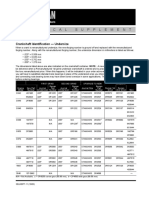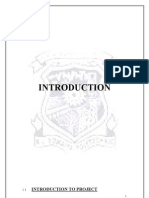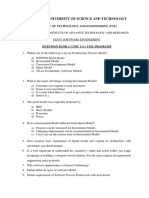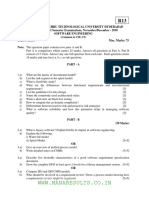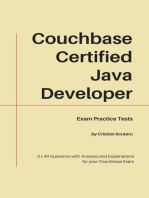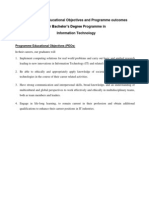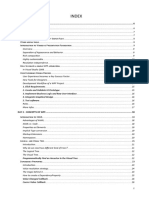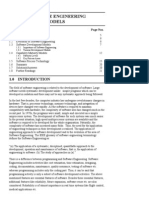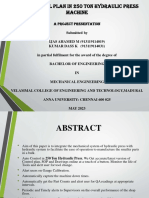0 ratings0% found this document useful (0 votes)
121 viewsSona College of Technology: U10It505 - Software Engineering
This document appears to be an exam for a Software Engineering course, consisting of multiple choice and short answer questions. It covers topics like software development lifecycles (e.g. waterfall, spiral), requirements analysis, software design, testing approaches (e.g. unit testing, regression testing), and software configuration management. The exam is divided into three parts - Part A contains 10 multiple choice questions, Part B contains 10 short answer questions, and Part C contains 5 long answer questions from which students must answer 5.
Uploaded by
DrPrakash G ChithappaCopyright
© Attribution Non-Commercial (BY-NC)
Available Formats
Download as DOC, PDF, TXT or read online on Scribd
0 ratings0% found this document useful (0 votes)
121 viewsSona College of Technology: U10It505 - Software Engineering
This document appears to be an exam for a Software Engineering course, consisting of multiple choice and short answer questions. It covers topics like software development lifecycles (e.g. waterfall, spiral), requirements analysis, software design, testing approaches (e.g. unit testing, regression testing), and software configuration management. The exam is divided into three parts - Part A contains 10 multiple choice questions, Part B contains 10 short answer questions, and Part C contains 5 long answer questions from which students must answer 5.
Uploaded by
DrPrakash G ChithappaCopyright
© Attribution Non-Commercial (BY-NC)
Available Formats
Download as DOC, PDF, TXT or read online on Scribd
You are on page 1/ 3
SONA COLLEGE OF TECHNOLOGY
(An Autonomous Institution)
SEMESTER END EXAMINATIONS NOV 2013
INFORMATION TECHNOLOGY
U10IT505 SOFTWARE ENGINEERING
Class: III Year / V Semester
Duration: 3 Hrs.
Max Marks: 100
PART A
Answer all the questions:
(10 x 1 = 10 marks)
1. Which statement best describe a meaning of "waterfall" life cycle model.
(a) When a phase in the lifecycle is completed, the results fall down to the next phase and
there is no going back.
(b) When a phase in the lifecycle iterates like a ring on the spiral, moving outward from the
center.
(c) When a phase in the lifecycle overlapping with each others.
(d) When a phase in the lifecycle is executed continuously without stop.
2. In the spiral model risk analysis is performed
(a) In the first loop (b) In the first and second loop (c) In every loop (d) Before using spiral
model.
3. If every requirement stated in the Software Requirement Specification (SRS) has only
one interpretation, SRS is said to be
(a) correct (b) unambiguous (c) consistent (d) verifiable.
4. This approach extends the requirements analysis process with the intention of reducing
overall life cycle costs.
(a) Evolutionary prototyping (b) Throw-away prototyping (c) Incremental development
(d) User interface prototyping
5. The ____________________ indicates how software will respond to external events or
stimuli.
(a) Control Flow Model (b) Data Flow Model (c) Behavioral Model (d) None of the above.
6. _________________testing is the re-execution of some subset of tests that have already
been conducted to ensure that changes have not propagated unintended side effects.
(a)
Regression (b) Integration (c) System (d) Acceptance.
7. At the architectural design level, a software architect uses an ____________________ to
model the manner in which software interacts with entities external to its boundaries.
(a) Data flow diagram (b) Architectural context diagram (c) Architecture flow diagram (d)
Entity-Relationship diagram.
8. The testing that focuses on the variables is called
(a) black box testing (b) white box testing (c) data variable testing (d) data flow testing.
9. _________________uses software failure analysis to collect information about all errors
and defects encountered as an application, system, or product is developed and used.
(a)
Statistical Software Process Improvement (b) Software Configuration Management
(c)
Software Project Management (d) Software Quality Assurance.
10. The_________________ is the set of mechanisms and data structures that allow a
software team to manage change in an effective manner.
(a) Software Configuration Management (b) SCM repository (c) Software Reliability (d)
Software Design
PART B
Answer all the questions:
(10 x 2 = 20 marks)
1.
2.
3.
4.
5.
6.
List out the umbrella activities of Software process.
Enumerate the drawbacks of Spiral model.
Differentiate between Software Verification and Validation.
What problems occur in Throw away prototyping?
What is the work product of software design process and who does it?
Why it is necessary to design the system architecture before specifications are
completed?
7. What are the different classes of test cases involved in regression testing?
8. Differentiate between Black box testing and White box testing.
9. What are the methods used in SCM Repository?
10. Write down the stages involved in Process improvement.
PART C
Answer any FIVE questions from the following:
(5 x 14 = 70 marks)
1. Describe at least one scenario where
(a) RAD model would be applicable and not the waterfall model.
(b) Waterfall model is preferable to all other models.
(7)
(7)
2. How does the analysis modeling help to capture unambiguous and consistent
requirements? Discuss several methods for requirements validation.
(5+9)
3. With suitable examples and required diagrammatic representation explain the Functional
Modeling in detail.
(14)
4. Explain clearly the concepts of coupling and cohesion? For each type of coupling give an
example of two components coupled in that way?
(8+3+3)
5. Discuss in detail about the following levels of testing:
(a) Unit Testing
(7)
(b) Acceptance Testing
(7)
6. How the layers Version Control and Change Control are effectively used in Software
Configuration process? Explain them briefly.
(14)
You might also like
- ISTQB Advanced Level Technical Test Analyst- Exam Insights: Q&A with ExplanationsFrom EverandISTQB Advanced Level Technical Test Analyst- Exam Insights: Q&A with ExplanationsNo ratings yet
- Caterpillar Remanufactured Products - CrankshaftNo ratings yetCaterpillar Remanufactured Products - Crankshaft4 pages
- Software Engineering MCQ Practice QuestionNo ratings yetSoftware Engineering MCQ Practice Question25 pages
- Midterm SW 2 2022-2023 Model A - Model AnswerNo ratings yetMidterm SW 2 2022-2023 Model A - Model Answer2 pages
- ايجولونكتلاو مولعلل نايبلا ةيلك Bayan College of Science & TechnologyNo ratings yetايجولونكتلاو مولعلل نايبلا ةيلك Bayan College of Science & Technology6 pages
- Department of Computer Science and Engineering Academic Year - 2010 - 11 (Odd Semester)No ratings yetDepartment of Computer Science and Engineering Academic Year - 2010 - 11 (Odd Semester)5 pages
- III CS - Software Project Management - Model Question paperNo ratings yetIII CS - Software Project Management - Model Question paper2 pages
- CSE - CS603 - SOFTWARE ENGINEERING - R18 - BookletNo ratings yetCSE - CS603 - SOFTWARE ENGINEERING - R18 - Booklet2 pages
- Software Engineering Question Bank eDAC May 21No ratings yetSoftware Engineering Question Bank eDAC May 2192 pages
- The University of Lahore: Department of Computer Science& IT Midterm Examination Fall-2020 (SOLUTION)No ratings yetThe University of Lahore: Department of Computer Science& IT Midterm Examination Fall-2020 (SOLUTION)5 pages
- IT3205 - Fundamentals of Software Engineering: University of Colombo, Sri LankaNo ratings yetIT3205 - Fundamentals of Software Engineering: University of Colombo, Sri Lanka5 pages
- Software Engireening Final Exam - July2023No ratings yetSoftware Engireening Final Exam - July20235 pages
- System Development Life Cycle (SDLC) McqsNo ratings yetSystem Development Life Cycle (SDLC) Mcqs7 pages
- Software Engineering Part 1 50 MCQ CEXAMINDIA (1) - UnlockedNo ratings yetSoftware Engineering Part 1 50 MCQ CEXAMINDIA (1) - Unlocked7 pages
- Department of Computer Science and Engineering Question BankNo ratings yetDepartment of Computer Science and Engineering Question Bank11 pages
- MITS5002 Software Engineering Methodologies: Final Assessment June 2020No ratings yetMITS5002 Software Engineering Methodologies: Final Assessment June 20205 pages
- Cryptography and Network Security: Third Edition by William StallingsNo ratings yetCryptography and Network Security: Third Edition by William Stallings22 pages
- Synchronous and Asynchronous Data TransferNo ratings yetSynchronous and Asynchronous Data Transfer18 pages
- M6 FORMATIVE3 VHDL Behavioral Programming 1No ratings yetM6 FORMATIVE3 VHDL Behavioral Programming 114 pages
- Advanced Digital System Design With FpgasNo ratings yetAdvanced Digital System Design With Fpgas2 pages
- Um2388 Development Guidelines For Stm32cube Firmware Packs StmicroelectronicsNo ratings yetUm2388 Development Guidelines For Stm32cube Firmware Packs Stmicroelectronics51 pages
- The OWASP Web Application Penetration Check ListNo ratings yetThe OWASP Web Application Penetration Check List19 pages
- CSV vs. CSA - What Are The Main Differences - ScilifeNo ratings yetCSV vs. CSA - What Are The Main Differences - Scilife25 pages
- FGSL/SSG Malabo, Equatorial Guinea: Dla 1A, Gebro 1A Bimod 2A Nly 1A, Visco 2ANo ratings yetFGSL/SSG Malabo, Equatorial Guinea: Dla 1A, Gebro 1A Bimod 2A Nly 1A, Visco 2A2 pages
- Department of Computer Science & Engineering Cs6502-Object Oriented Analysis and Design Unit Iii Case StudyNo ratings yetDepartment of Computer Science & Engineering Cs6502-Object Oriented Analysis and Design Unit Iii Case Study4 pages
- Doc-20231219-Wa0034. 20231219 164426 0000No ratings yetDoc-20231219-Wa0034. 20231219 164426 000031 pages
- JNTU Kakinada - 2014 - AUTOMOTIVE CONTROL SYSTEMS PP PDFNo ratings yetJNTU Kakinada - 2014 - AUTOMOTIVE CONTROL SYSTEMS PP PDF4 pages


